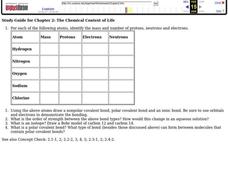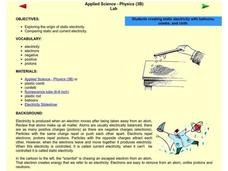Curated OER
Atoms, Molecules, and Ions
In this molecules worksheet, students review the parts of an atom and use element mass to determine isotopes. Students give the group, period, and classification for the given elements. This worksheet has 6 short answer questions and 17...
Curated OER
Static!
Fifth graders explore static electricity. They listen to and discuss the book, 'All About Electricity,' participate in two experiments, and design and present a static electricity demonstration.
Curated OER
A Hair Raising Experience
Fifth graders conduct an investigation using glass, metal ,fur, latex balloon, plastic bag and hair to generate static electricity of varying amounts. They predict, observe, make comparisons, and draw conclusions about static electricity...
Curated OER
Teaching Atomic Structure Using Cooperative Learning
Individuals in a group of four each take on a different role: atomic number expert, mass number expert, isotope expert, and nuclear atom expert. They teach each other about their area of expertise. As an assessment, a short quiz is...
Curated OER
Defining the Atom
Words, words, words! This presentation uses plenty of them to define the atom, outline the history of what we know about atoms, and explain atomic and mass numbers. That's all! Informative, but not interesting, this slide show would be...
Curated OER
The Chemical Context of Life
In this chemistry worksheet, students fill in the chart for question one. The chart is filled out examining the mass, protons, electrons, and neutrons for specific atoms.
Curated OER
Understanding Oxidation Numbers
Students review atomic numbers, positive and negative charges, and the periodic table. They examine the relationships among protons and electrons, location of various elements, electron energy levels, and oxidation numbers.
Curated OER
Matter: All That "Stuff"
In this chemistry worksheet, students learn about matter, including atoms, electrons, protons, neutrons, compounds and chemical properties. They use this information to answer the 10 questions on the worksheet. The answers are on the...
Curated OER
Making Atoms
In this atoms instructional activity, students determine an atoms based on its protons, and neutrons. Students determine the electron levels for the oxygen atom. This instructional activity has 1 multiple choice, 4 fill in the blank, and...
Curated OER
The Atom
In this atom worksheet, high schoolers read about the structure of the atom including its subatomic particles and John Dalton's theory of the atom. Students also read about the differences between atoms, molecules and compounds. They...
Curated OER
The Atoms Family Album
In the atom activity, students read a story about the "Atoms Family" and are given descriptions of the structures of atoms through the story. Students interpret the descriptions by drawing the described atom structure, they name of the...
Curated OER
Static Electricity
In this static electricity worksheet, learners experiment with balloons, plastic bags and flannel clothes to observe attraction and repulsion of objects. Students complete three data tables indicating the charge on the objects and if...
Curated OER
Applied Science - Physics Lab
Students explore electricity. In this Physics lesson, students investigate the origin of static electricity. Students compare static electricity to current electricity.
Curated OER
Applied Science - Physics (K) Post Lab
Students are introduced to electricity. In this electricity lesson, students listen to the book Switch on, Switch off by Melvin Berger and discuss the use of electricity in light switches. They create a picture of an atom using pom...
Curated OER
Physical Science Project-Atom
Fifth graders investigate atoms. For this atom lesson, 5th graders investigate the parts of an atom. Students explore atom numbers and determine the number of electrons is in each atom.
Curated OER
Metals and Nonmetals
In this elements worksheet, learners determine if the given elements are metals or nonmetals. Students give the valence electrons for other elements. This worksheet has 10 fill in the blank questions.
Curated OER
Periodic Table & Its Trends-Day 1
Pupils are introduced to the periodic table. They find the common trends among the electron configurations and the names of certain groups of the table. Students explore the atomic mass, atomic number, mass number, mass and charge...
Curated OER
Periodic Table & Its Trends
Students review atomic structure and then participate in a activity in which they categorize several "elements" into some form of order based on their properties. They discuss the trends they see. They also practice several electron...
Curated OER
The Physical Setting
Students study atoms and their protons and neutrons. In this physical setting lesson students work together to complete a lab activity.
Curated OER
A Guided Tour of the Periodic Table
In this periodic table activity, students write the chemical symbols for the given elements, compare atomic number and mass number, and describe the importance of valence electrons in the organization of the periodic table. This activity...
Shelby County Schools
Atomic Structure Worksheet
Teaching young scientists about atoms is no small task, but this series of worksheets will make it a little easier. From creating and labeling Bohr models, to identifying information provided in the periodic table of elements,...
Curated OER
Atoms, Ions and Formula Basics Make-up Test
Using a copy of the periodic table, chemistry test takers fill in a chart with element name, chemical symbol, atomic number, atomic mass, and numbers of subatomic particles. They define subatomic particles, draw atom models, explain...
Curated OER
Atomic Structure
The first nine slides visit the history of our understanding of atoms. The next several outline the structure of atoms. Subatomic particles, electron configuration, and diagramming methods are introduced. This is a neatly organized...
Curated OER
Isotopes
In this isotopes worksheet, students review mass number, molecular notation, electron attraction, and electron orbits. This worksheet has 5 matching and 5 short answer questions.

























